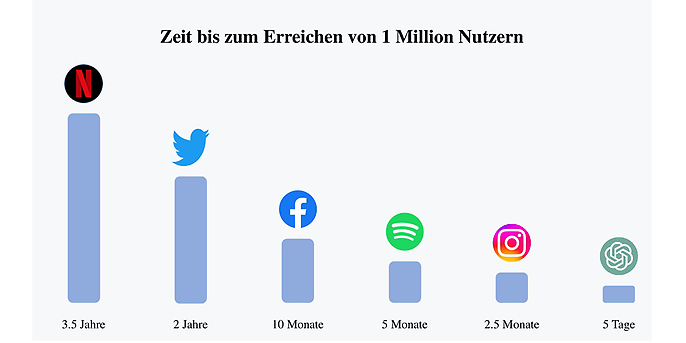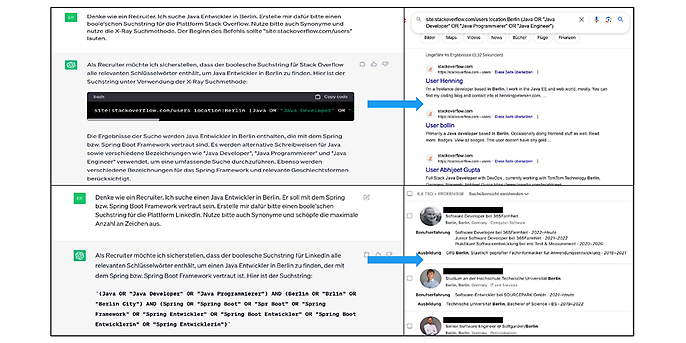4. August 2023 By Erik Langnickel
ChatGPT – does it represent the future of recruiting?
ChatGPT is an advanced AI technology developed by OpenAI based on the GPT-3.5 architecture. The initials ‘GPT’ are short for Generative Pre-trained Transformer, with ChatGPT being a special implementation of this model for dialogue and interaction using natural language. At its core, ChatGPT is a neural network trained on an enormous dataset of texts in order to understand language patterns and contexts. It is a language model that is capable of generating long texts and reacting to input from users.
After ChatGPT-3 was made available to the public free of charge on 30 November 2022, one million users worldwide registered within five days to use the new version of the software. To better understand just how successful ChatGPT has been compared to other platforms, take a look at the graph below.

Time to reach the one-million-user mark for various platforms
The number one reason for the hype surrounding the AI language model is down to how easy and intuitive ChatGPT is to use. For the first time, people around the world were able to interact with artificial intelligence without having to have any computer skills whatsoever.
DirectSearch at adesso
The DirectSearch team at adesso is part of the recruiting process, specialising on direct communication with candidates. We actively reach out to our target group on a variety of platforms such as Xing, LinkedIn, Honeypot, GitHub and Stack Overflow. After that, we are there to support the process start to finish, from initial contact and the first meeting with the candidate to the time they sign a contract with us. The team’s other tasks include setting up talent pools and networks, providing support at (select) trade fairs and preparing regular competitive analyses and status reports within the departments. We are currently a team of 20 distributed all across Germany.
How ChatGPT influences our work in the DirectSearch team
ChatGPT offers potential in a number of areas in our day-to-day work in the DirectSearch team. Here is a list of some of everyday use cases:
- Generating Boolean search strings
- Generating lists of target companies
- Providing inspiration for creative texts and subject lines directed at the person or group being targeted
- Providing inspiration on where best to find a specific target group
- Generating code snippets for different applications (such as adesso Benefits in the form of Java code)
- Generating interview questions and/or case studies
- Creating simple explanations for complex scenarios and/or technologies
- Generating ideas for recruiting campaigns
- Writing texts for administrative tasks (such as e-mail invitations for scheduled interviews)
Of all the possible use cases described above, we will be taking a closer look at two of them now: search string generation and the generation of texts directed a target group.
Generating Boolean search strings
Our everyday work involves identifying the right talents and getting them excited about adesso. Among other things, we use Boolean search strings to narrow down our target group. To explain, a Boolean search is a special type of search that uses Boolean operators to create precise and efficient search queries. The Boolean operators, named after the British mathematician and logician George Boole, are basic logical operators, these being AND, OR and NOT. These operators allow us to create complex queries by connecting a series of keywords. The screenshot below illustrates how ChatGPT on the Stack Overflow (top) and LinkedIn (bottom) platforms can assist us in this task.

Support from ChatGPT in creating Boolean search strings on Stack Overflow and LinkedIn
As you can see, ChatGPT helps us to generate complex search strings that then allow us to interact with our target audience. On LinkedIn alone, we received over 6,800 possible profiles of Java developers from Berlin thanks to ChatGPT. This approach can also be adopted with other platforms such as Xing, GitHub or Twitter.
Providing inspiration for creative texts and subject lines directed at the person or group being targeted
One of the main goals of our work is to stand out from the crowd and draw a potential job applicant’s attention to adesso through a well-written, personalised approach. The keys to success in direct communication with candidates are: personalisation, being creative and the length of the message directed at the candidate. None of these aspects should be neglected. So far, ChatGPT has not been able to write personalised cover letters that precisely match a person’s profile or that are up to the quality of the cover letters we could write ourselves. Rather, they are less formal generic cover letters, with certain minor improvements made. As a good general recommendation, however, you can let yourself be inspired by ChatGPT and use individual passages from the text it generates.
When it comes to subject lines, on the other hand, ChatGPT is great because the results are often very creative and stand out from the crowd. Here is an example: ‘Java Jedi needed in Berlin! May the code be with you!’.
Prompt engineering
With all the hype surrounding ChatGPT and the associated potential of AI, the importance of humans should not be neglected. In relation to AI, especially when using AI language models such as ChatGPT, the term ‘prompt’ refers to the starting point or initial question being asked of the model in order to generate a response. It is the text or query that establishes the context and framework for the AI model’s response. The more precise the prompt is, the more accurate the AI’s response will be. Therefore, people should be taught what a good prompt is and how to create precise prompts. The goal here is to form the best possible alliance between AI and humans. The person should therefore know how to use the AI and how to continue working with the results or the text output by ChatGPT. For this very reason, the profession of prompt engineer will most likely continue to grow more and more important as we go forward. The first group of companies in Germany has already posted job advertisements for prompt engineers.
Challenges and risks
Data protection
The use of ChatGPT requires the transfer of data to external servers in a third country outside the EU, which raises privacy and security concerns and presents the risk that sensitive or personal information could be disclosed. For that reason, it is important that appropriate safeguards are in place to protect the data. As such, it is important to take care not to disclose personal or confidential information when entering a prompt.
Human interaction
The primary use of ChatGPT should be about ensuring the best possible interaction between humans and machines, since even an AI will sometimes make mistakes. Because of this, it is necessary to monitor AI models and subject them to human quality control to prevent the risks described below:
- Misinformation and bias: AI language models can be prone to spreading misinformation or giving biased responses because these are generated based on the data the models have been trained on.
- Reliant on unverified information: Users may be misled into thinking that AI language models are a source of reliable information without checking the accuracy of the responses.
- Ethics and moral responsibility: The use of ChatGPT raises ethical issues, particularly in relation to who is responsible for the content that is created. Because AI systems are autonomous, it can be difficult to identify who is responsible for problematic or harmful content.
- Output control: With AI models such as ChatGPT, the flow of the conversation may not be as we would like it to be or the models may generate unexpected responses, which can make it difficult to control the output.
Conclusion and outlook
There is no denying that ChatGPT has changed how work is done in recruiting and DirectSearch and will continue to influence this in future. The use cases presented above, including the generation of search strings or the providing inspiration for texts and subject lines directed at a target group, are just a few examples of how ChatGPT can be used.
However, with all its potential as well as the risks and challenges it brings with it, especially in the area of data protection, it is important to always consider the human factor when using the model. ChatGPT and other AI tools will most likely be used in all other HR fields in the future. For example, ChatGPT can be used to write and improve job advertisements, develop onboarding plans and generate ideas for employer branding campaigns.
Besides ChatGPT, there are a number of other AI tools like Midjourney AI, Auto GPT and Noty.ai. With all the reports coming out about new AI tools, it is important not to get lost in the maze of AI tools, but instead limit yourself to a reasonable number of tools that support you in your work.
You can find more exciting topics from the adesso world in our blog articles which have published so up to now.

